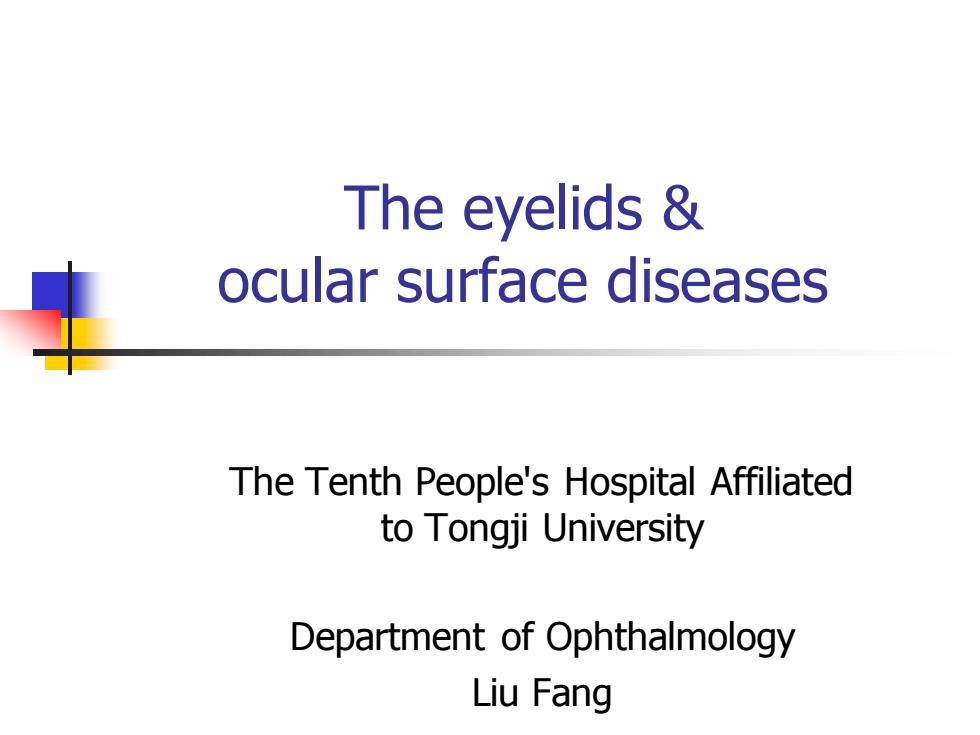
The eyelids ocular surface diseases The Tenth People's Hospital Affiliated to Tongji University Department of Ophthalmology Liu Fang
The eyelids & ocular surface diseases The Tenth People's Hospital Affiliated to Tongji University Department of Ophthalmology Liu Fang

一、 eye lids diseases l、Overview Anatomy The skin layer:thin 提上脸肌 The subcutaneous tissue layer: 眼轮匝肌 上脸板肌 easy to edema Muscle layer the orbicularis oculi muscle,Levator muscle of upper 脸板 eyelid Tarsal plate layer dense 皮肤 睑结膜 connective tissue 睑板腺 √Meibomian gland(the largest of缘腺 the sebaceous gland) 睫毛 conjunctiva layer:Palpebral conjunctiva
一、eye lids diseases 1、 Overview Anatomy ✓The skin layer: thin ✓The subcutaneous tissue layer: easy to edema ✓Muscle layer : the orbicularis oculi muscle, Levator muscle of upper eyelid ✓Tarsal plate layer : dense connective tissue ✓Meibomian gland (the largest of the sebaceous gland) ✓conjunctiva layer:Palpebral conjunctiva

2.Disease Classification Inflammation-contact dermatitis, hordeolum Figure 14A.Extemal hordeolum.If there are no com Figure 14B.External hordeolum.A complication due to plications,it disappears with suppuration in a short time. inadequate management is observed in this patient
2. Disease Classification ◼Inflammation → contact dermatitis, hordeolum ◼
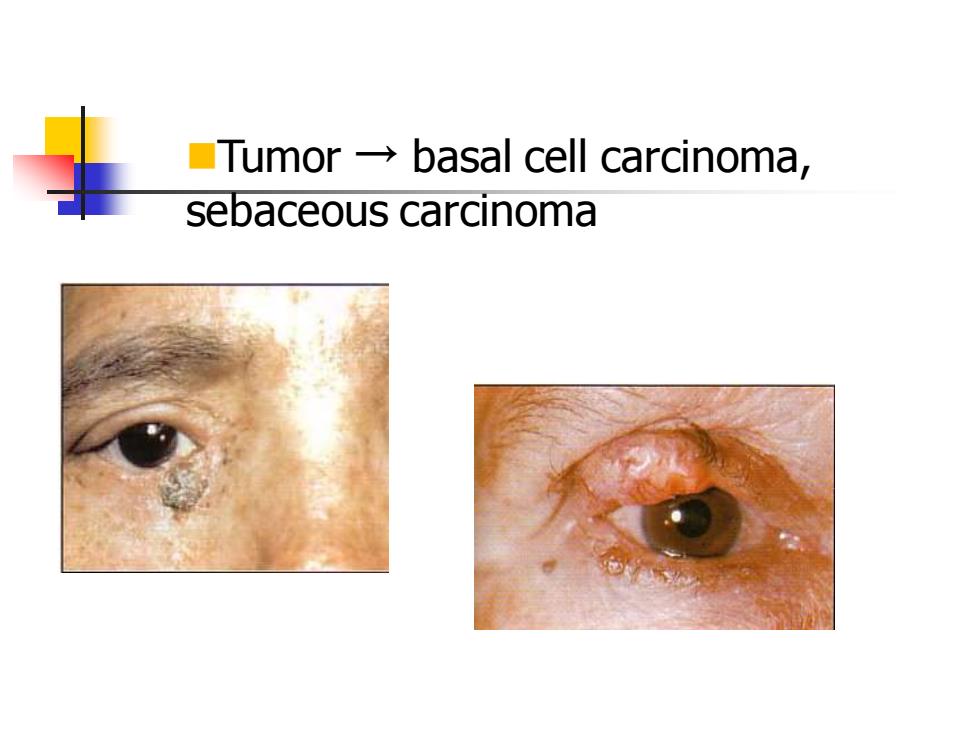
Tumor-basal cell carcinoma, sebaceous carcinoma
◼Tumor → basal cell carcinoma, sebaceous carcinoma
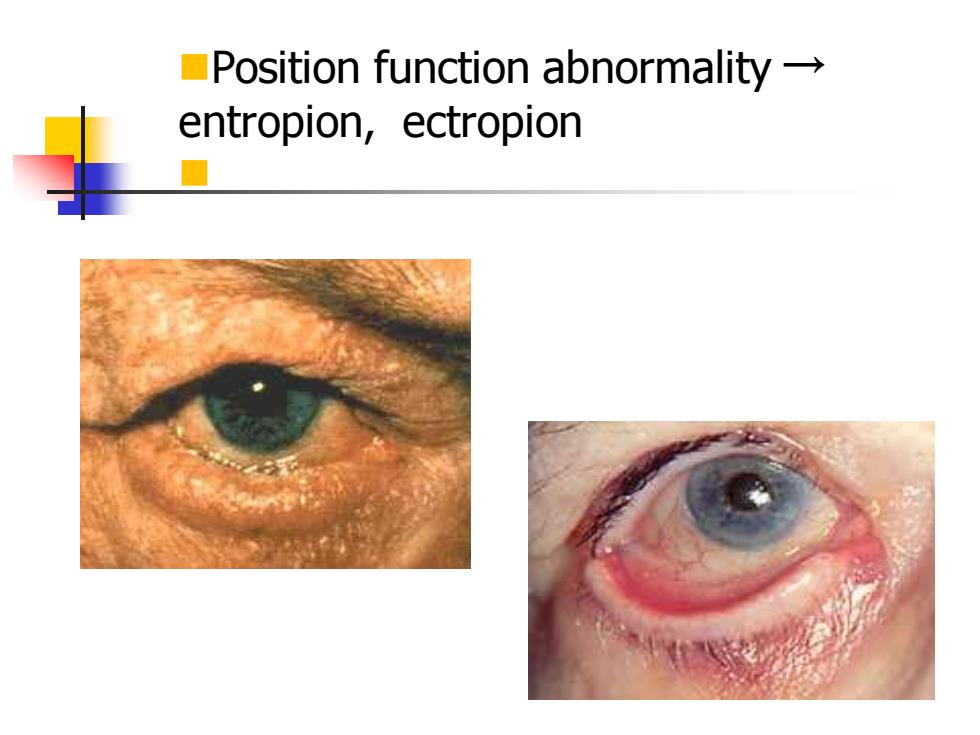
■Position function abnormality→ entropion,ectropion
◼Position function abnormality → entropion, ectropion ◼

Congenital anomalies- ptosis
◼Congenital anomalies → ptosis
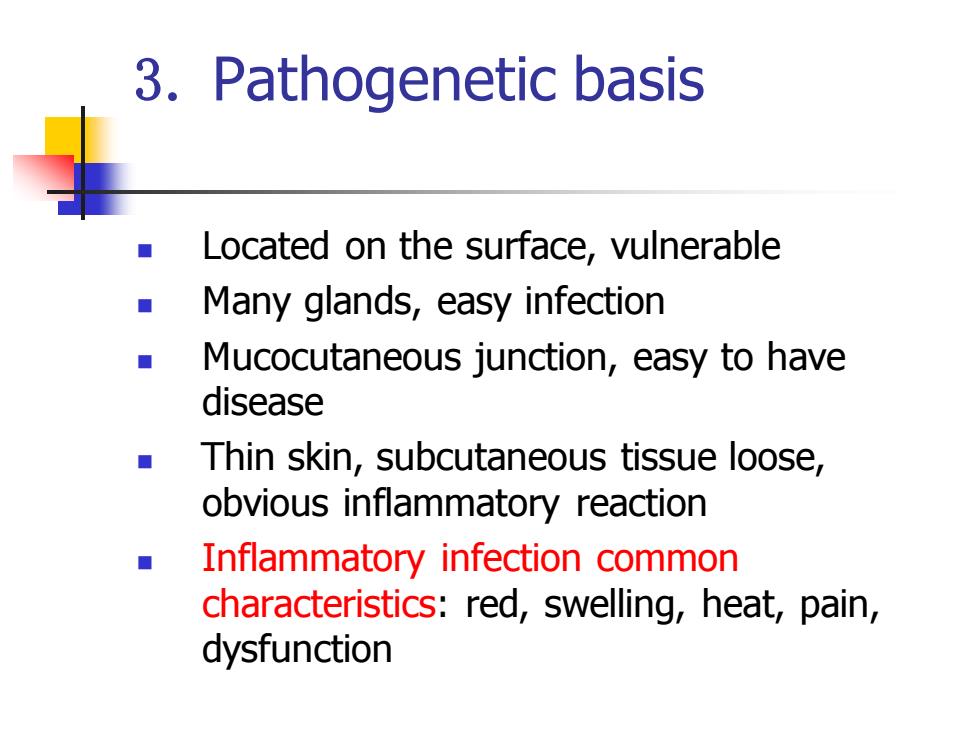
3.Pathogenetic basis Located on the surface,vulnerable Many glands,easy infection ■ Mucocutaneous junction,easy to have disease ■ Thin skin,subcutaneous tissue loose, obvious inflammatory reaction Inflammatory infection common characteristics:red,swelling,heat,pain, dysfunction
3. Pathogenetic basis ◼ Located on the surface, vulnerable ◼ Many glands, easy infection ◼ Mucocutaneous junction, easy to have disease ◼ Thin skin, subcutaneous tissue loose, obvious inflammatory reaction ◼ Inflammatory infection common characteristics: red, swelling, heat, pain, dysfunction
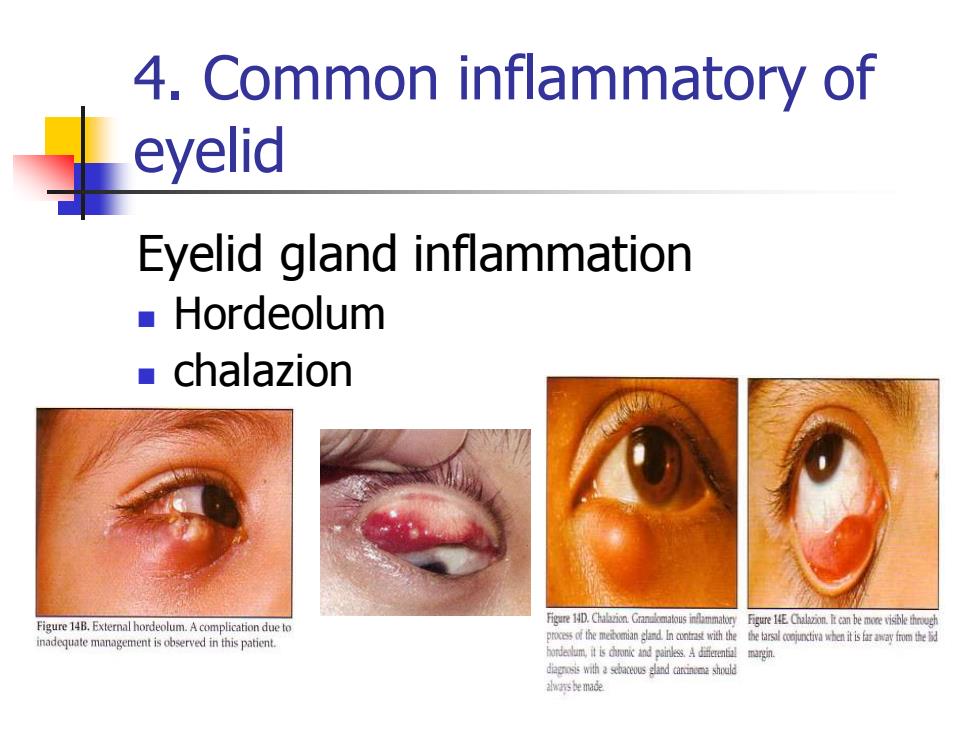
4.Common inflammatory of eyelid Eyelid gland inflammation ■Hordeolum ■chalazion Figure 14B.Extemal hordeolum.A complication due to inadequate management is observed in this patient. theadnth thehiiism 5 isicd paines.A插ar恤agn as弹品使
4. Common inflammatory of eyelid Eyelid gland inflammation ◼ Hordeolum ◼ chalazion
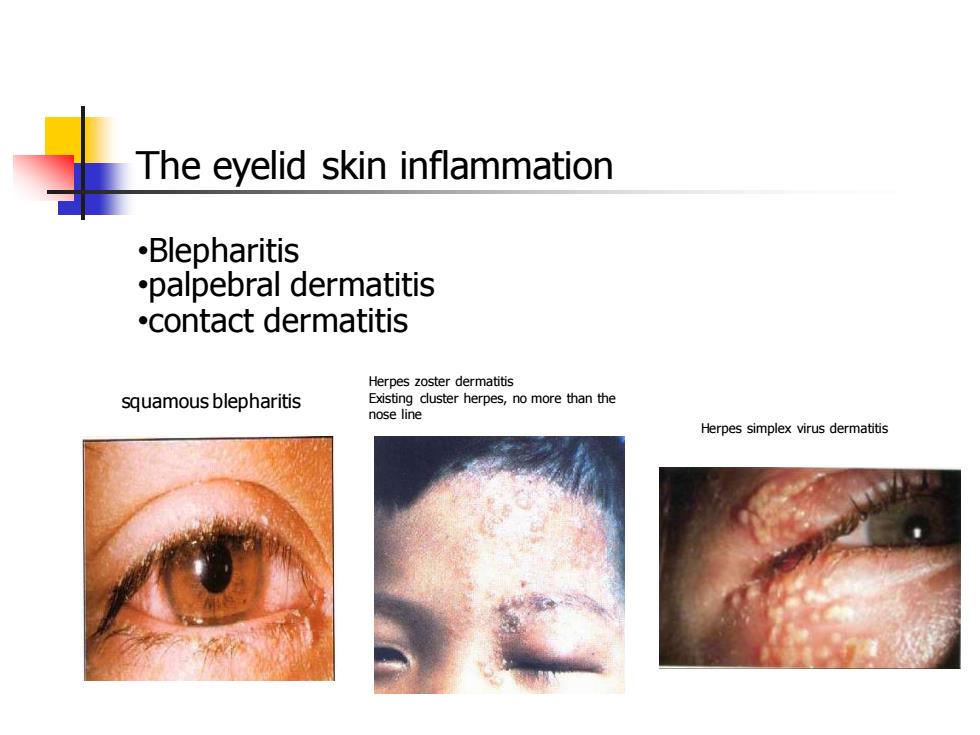
The eyelid skin inflammation Blepharitis palpebral dermatitis .contact dermatitis Herpes zoster dermatitis squamous blepharitis Existing cluster herpes,no more than the nose line Herpes simplex virus dermatitis
The eyelid skin inflammation •Blepharitis •palpebral dermatitis •contact dermatitis Herpes zoster dermatitis Existing cluster herpes, no more than the nose line Herpes simplex virus dermatitis squamous blepharitis
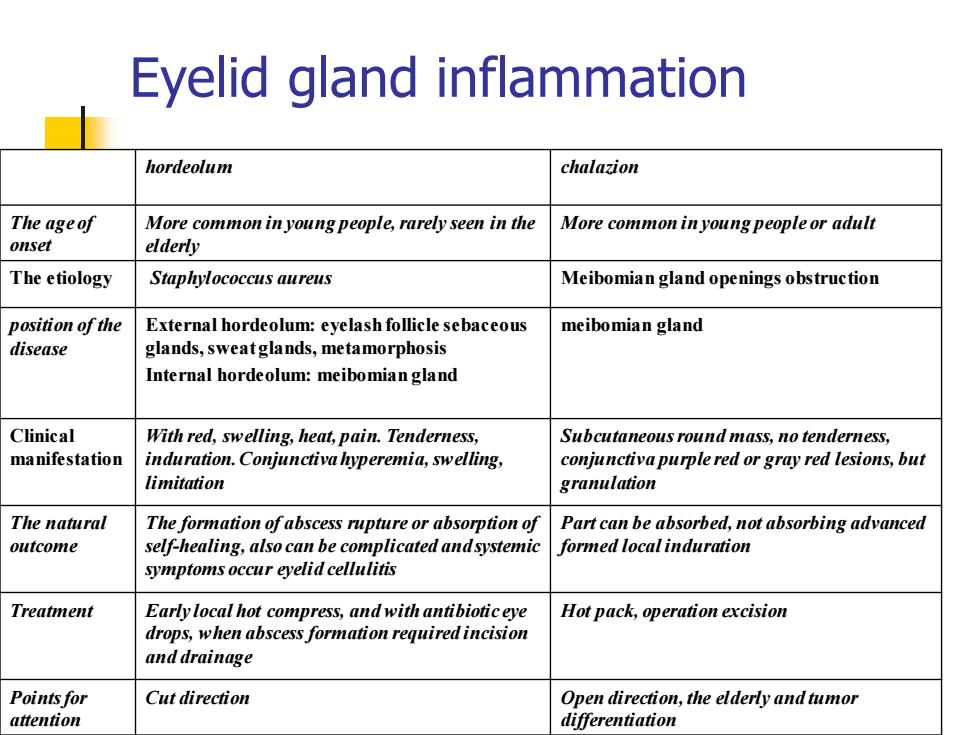
Eyelid gland inflammation hordeolum chalazion The ageof More common in young people,rarely seen in the More common inyoung people or adult onset elderly The etiology Staphylococcus aureus Meibomian gland openings obstruction position of the External hordeolum:eyelash follicle sebaceous meibomian gland disease glands,sweatglands,metamorphosis Internal hordeolum:meibomian gland Clinical With red,swelling,heat,pain.Tenderness, Subcutaneous round mass,no tenderness, manifestation induration.Conjunctiva hyperemia,swelling, conjunctiva purple red or gray red lesions,but limitation granulation The natural The formation of abscess rupture or absorption of Part can be absorbed,not absorbing advanced outcome self-healing,also can be complicated andsystemic formed local induration symptoms occur eyelid cellulitis Treatment Early local hot compress,and with antibioticeye Hot pack,operation excision drops,when abscess formation required incision and drainage Points for Cut direction Open direction,the elderly and tumor attention differentiation
Eyelid gland inflammation hordeolum chalazion The age of onset More common in young people, rarely seen in the elderly More common in young people or adult The etiology Staphylococcus aureus Meibomian gland openings obstruction position of the disease External hordeolum: eyelash follicle sebaceous glands, sweat glands, metamorphosis Internal hordeolum: meibomian gland meibomian gland Clinical manifestation With red, swelling, heat, pain. Tenderness, induration. Conjunctiva hyperemia, swelling, limitation Subcutaneous round mass, no tenderness, conjunctiva purple red or gray red lesions, but granulation The natural outcome The formation of abscess rupture or absorption of self-healing, also can be complicated and systemic symptoms occur eyelid cellulitis Part can be absorbed, not absorbing advanced formed local induration Treatment Early local hot compress, and with antibiotic eye drops, when abscess formation required incision and drainage Hot pack, operation excision Points for attention Cut direction Open direction, the elderly and tumor differentiation